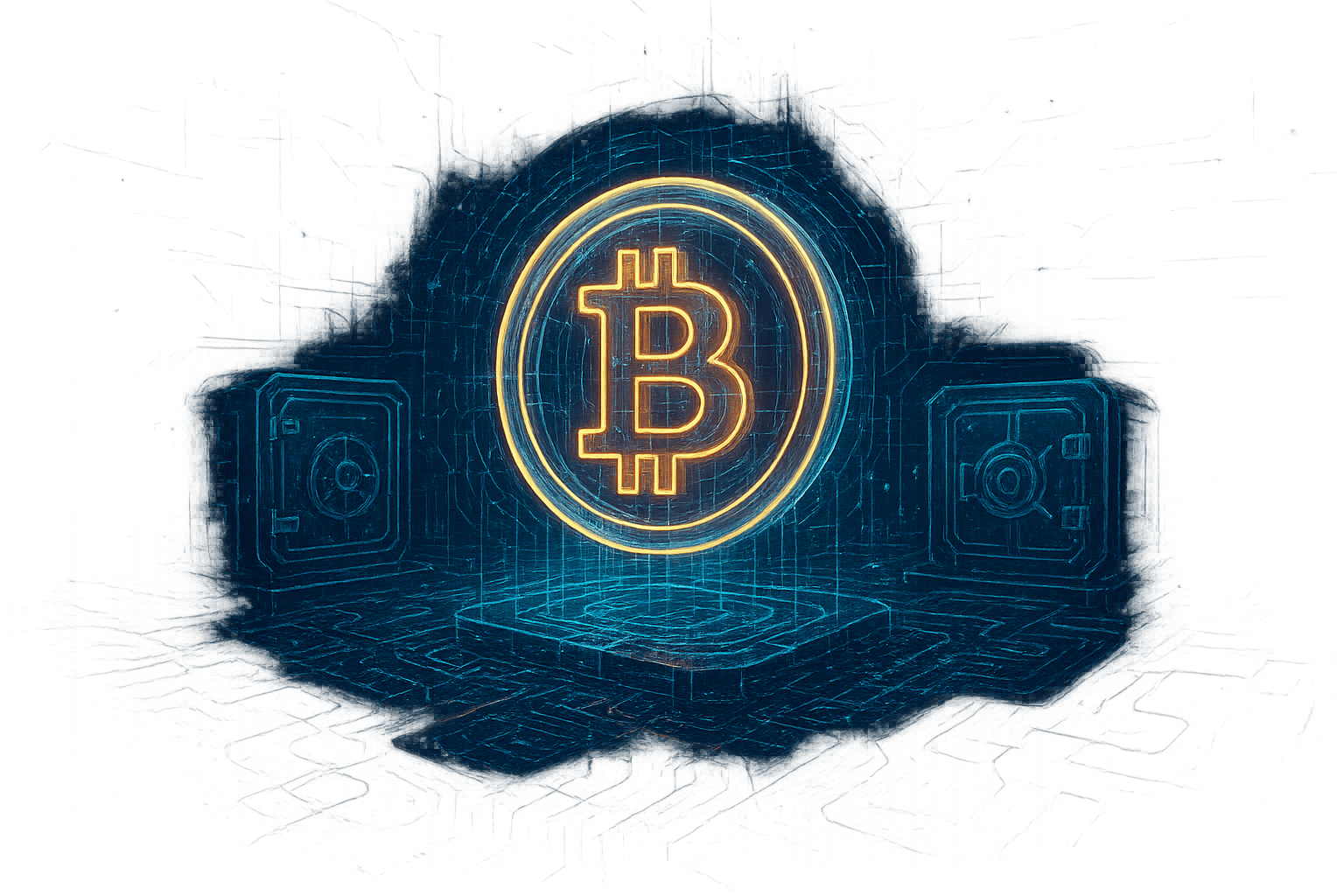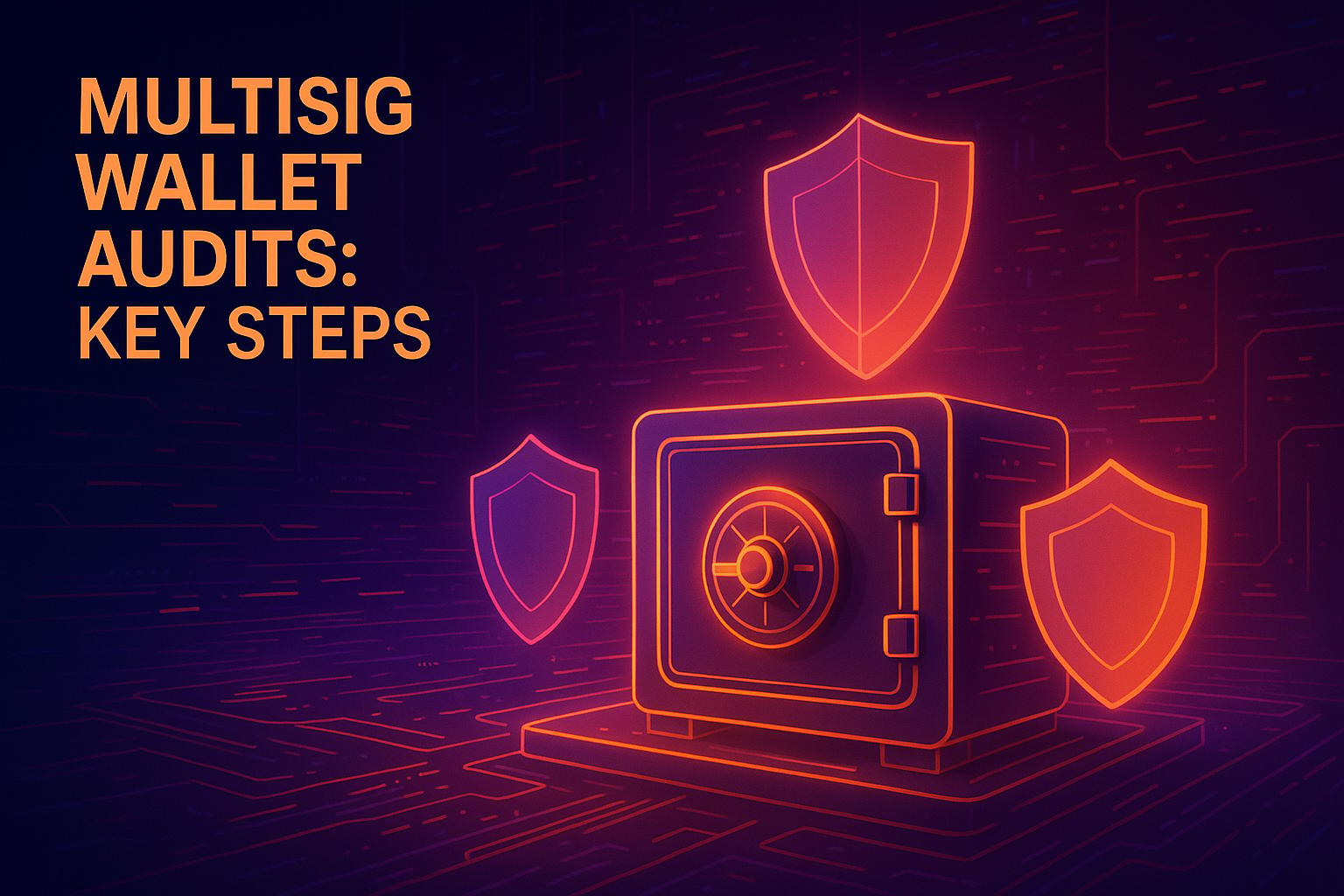Securing your Bitcoin is non-negotiable. Losing access to your private keys or seed phrases can result in permanent loss of funds. This guide dives into Bitcoin backup redundancy - a strategy to protect your wallet by creating multiple secure backups to withstand cyberattacks, hardware failures, human errors, or natural disasters.
Key Takeaways:
- Why it matters: Protects your Bitcoin from loss due to theft, device failure, or physical disasters.
- Backup methods: Options include paper backups, steel plates, encrypted MicroSD cards, and multisig wallets.
- Storage tips: Use fireproof safes, bank safety deposit boxes, and geographically diverse locations.
- Avoid digital backups: Cloud services, photos, and emails are vulnerable to hacking and compromise self-custody principles.
- Advanced strategies: Multisig wallets, time-delayed transactions, and secret notifications enhance security.
Quick Action Plan:
- Create at least two physical backups (e.g., steel plates or laminated paper).
- Store backups in separate, secure locations.
- Test recovery regularly with small Bitcoin amounts.
- Use multisig setups for larger holdings.
- Remove all digital copies of your seed phrase.
Conclusion: A solid backup strategy ensures you retain control over your Bitcoin, even in the face of unexpected challenges. Regular audits and advanced tools like multisig wallets can further protect your assets. Start securing your Bitcoin today by implementing these steps.
Bitcoin Backup Methods and Storage Practices
Common Bitcoin Backup Methods
When protecting your seed phrases and private keys, it’s essential to choose reliable methods that suit your needs. Each option has its strengths, so combining them can create a solid backup plan.
Paper backups are simple and widely used. Write your 12- or 24-word seed phrase on high-quality, archival paper, and consider laminating it for added durability. However, paper can degrade over time and is vulnerable to water, fire, and physical wear, so it’s not foolproof.
Steel backups provide a much more durable alternative. These involve engraving or stamping your seed phrase onto stainless steel plates. Steel backups can withstand extreme temperatures (up to 1,400°F), resist corrosion, and survive disasters like house fires or floods that would destroy paper copies.
Encrypted MicroSD cards offer a mix of digital convenience and offline security. By storing encrypted wallet files, these cards are discreet and less likely to attract unwanted attention. For even greater security, you can incorporate multisig setups. Services like BitVault allow you to distribute backup responsibilities, requiring only a subset of keys for fund recovery. This setup enhances both flexibility and security.
Secure Storage Practices
The key to effective backup storage is redundancy and geographic diversity. Relying on a single location or method leaves your backups vulnerable to unforeseen events.
Home safes are a popular choice for storing physical backups. Use a fireproof safe rated for at least 1 hour at 1,700°F to protect against fire damage. However, safes can be stolen or destroyed in severe disasters, so they should be part of a broader strategy, not your only solution.
Bank safety deposit boxes offer professional security and are located away from your home, adding an extra layer of protection. Banks enforce strict access controls and monitoring, making them a secure option for storing seed phrases or hardware wallets. The downside is limited access hours and the inconvenience of traveling to retrieve your backup.
Consider storing backups in multiple geographic locations. For example, you could entrust copies to family members in different cities or states. This approach protects against regional disasters like hurricanes, earthquakes, or widespread power outages that could affect all local storage options at once.
When planning your storage strategy, think about accessibility scenarios. You’ll need a way to recover your funds if you’re traveling, if your primary location becomes inaccessible, or if someone you trust needs to assist you. Document your storage locations and access procedures carefully, ensuring they’re clear enough for authorized individuals to follow without compromising security.
Environmental factors also matter. Basements can flood, attics can overheat, and garages often experience extreme temperature fluctuations. Choose storage locations with stable conditions to avoid damaging your backups.
Why to Avoid Digital Backup Storage
While physical backups are the most secure option, it’s important to understand why digital backups can be risky. Storing your seed phrase digitally introduces vulnerabilities that undermine the very security you’re trying to achieve.
Cloud services and password managers may offer encryption, but their centralized nature makes them targets for hackers and legal actions. These services can be breached, shut down, or even seized, putting your private information at risk.
Photos and screenshots of seed phrases are particularly dangerous. They often sync automatically to cloud storage, creating multiple copies across devices. These images can also be accidentally shared or accessed by others. Additionally, photo files often contain metadata that can reveal when and where the image was taken, providing potential attackers with valuable clues.
Email and messaging apps are equally risky for storing or sharing seed phrases. Messages can be intercepted, stored indefinitely on servers, or accessed by service providers and government agencies.
The core issue with digital storage is that it contradicts Bitcoin’s principle of self-custody. By storing your seed phrase digitally, you’re placing trust in third parties, which defeats the purpose of holding Bitcoin in the first place. Physical backups keep full control in your hands while providing the redundancy needed for long-term security.
For users of advanced wallets like BitVault, features like time-delayed transactions and secret notifications add extra protection. However, these tools don’t replace the need for secure physical storage of your primary seed phrases and recovery details. Physical methods remain the cornerstone of a strong Bitcoin backup plan.
Advanced Backup Redundancy Strategies
Multisig Wallets for Backup Distribution
Once you’ve nailed down the basics of backing up your Bitcoin wallet, adding multisig wallets to your strategy can take security to the next level. Multisig wallets require multiple signatures to approve transactions, which spreads the risk across several keys and locations, minimizing the chance of a single point of failure.
Take the 2-of-3 multisig setup as an example. Here, you generate three separate keys, but only two are needed to access your funds. This means losing one key doesn’t lock you out of your Bitcoin. You could store one key at home, another in a bank’s safety deposit box, and entrust the third to a family member in a different state. Even if one location is compromised, your funds remain safe and accessible.
For those managing larger amounts, a 3-of-5 setup can add even more layers of security. This configuration requires three signatures out of five keys, making it ideal for those who need higher redundancy. While this setup offers greater protection, it does require more effort to coordinate.
Tools like BitVault simplify the process of managing multisig wallets. You maintain control over your keys, but the wallet handles the coordination behind the scenes, making the process seamless without sacrificing security.
Time-Delayed Transactions and Secret Notifications
Multisig wallets are a strong foundation, but advanced features like time-delayed transactions and secret notifications can safeguard your assets against coercion or theft. These measures add automatic protections that kick in when you’re under duress.
Time-delayed transactions introduce a waiting period before funds can be moved. For example, if someone forces you to transfer Bitcoin, the transaction won’t go through immediately. Instead, it’s delayed (e.g., 24–48 hours), giving you time to cancel it using a separate recovery mechanism once you’re out of harm’s way. This feature acts as a buffer, ensuring your funds remain secure even if you’re pressured into making a transaction.
Secret notifications take things a step further. These alerts notify trusted contacts when suspicious activity occurs, such as a transaction initiation, a triggered delay, or an attempt to change your wallet's security settings. BitVault’s implementation sends these notifications through encrypted channels, like email or SMS, and operates independently of your main device. So, even if your phone or computer is compromised, the alerts still get through.
BitVault combines these features with AES 256-bit encryption and allows you to customize transaction delays based on your needs. For instance, high-net-worth users may opt for longer delays on large transactions, while everyday users might choose shorter delays for convenience. Additionally, the system integrates with Bitcoin Layer 2 solutions like the Lightning Network, ensuring small transactions remain quick and hassle-free while larger holdings benefit from added protection.
Balancing Multiple Backups and Security
Managing multiple backups is all about finding the sweet spot between redundancy and security. While having several backups reduces the risk of losing access to your funds, it also increases the number of potential attack points. Striking this balance requires careful planning and execution.
One key element is using strong passphrases. Think of a passphrase as an extra layer of protection - a “25th word” added to your seed phrase. Even if someone gets their hands on one of your backups, they can’t access your funds without the passphrase. This allows you to create more backups without worrying as much about unauthorized access.
You can also assign different security levels to your backups. For instance, your primary backup might live in a bank vault, while secondary copies could be distributed among trusted family members, each protected by an additional passphrase. This layered approach ensures that even if one backup is compromised, the rest remain secure.
Clear documentation is essential when managing multiple backups. Keep track of where each backup is stored, who has access, and how to recover your funds if needed. However, don’t store this documentation alongside your backups. Instead, create a recovery instruction sheet that outlines your strategy without revealing sensitive details like exact locations or passphrase hints.
Advanced features like time-delayed transactions can make managing multiple backups less risky. If one backup is compromised, the delay system gives you time to react and secure your funds using another backup.
Finally, commit to regular backup audits. Every six months, check that all your backup locations are secure and accessible. Test your recovery process with small amounts to ensure everything works smoothly. Update your documentation if you move backups or tweak your security setup. This ongoing maintenance keeps your redundancy strategy effective as your needs evolve.
Bitcoin Backup Solution Comparison
Backup Solution Comparison Table
Below is a comparison of popular Bitcoin backup strategies, evaluating their resistance to environmental factors, durability, security, cost, and ideal use cases.
| Backup Method | Fire Resistance | Water Resistance | Durability | Security Level | Cost Level | Best Use Case |
|---|---|---|---|---|---|---|
| Steel Plates | Excellent – designed to withstand extreme heat | Excellent – resistant to moisture-related damage | Very long-lasting | High, especially with additional markings or engraving | Moderate | Primary long-term storage |
| Paper Wallets | Low – susceptible to heat damage | Low – vulnerable to water damage | Limited durability | Moderate when laminated, but not ideal as the sole backup | Low | Temporary or secondary backup |
| Hardware Wallets | Limited – not designed to withstand physical hazards | Limited – sensitive to environmental elements | Moderate durability | High, provided they are maintained and paired with secure seed backups | Moderate | Active use with an offline seed backup |
| Multisig Setup | Dependent on the physical security of storage | Dependent on the method used for key backups | Varies | Very high due to distributed key management | Higher | High-value holdings requiring enhanced layered security |
This table offers a snapshot of each method's strengths. Below, we’ll dive deeper into what makes each strategy unique.
Steel plates stand out for their ability to withstand harsh conditions, making them a solid choice for long-term storage. Paper wallets are inexpensive but fragile, better suited as temporary or secondary backups. Hardware wallets provide robust active security but should always be paired with a secure seed backup for full protection. Multisig setups, on the other hand, distribute risk across multiple keys and locations, offering an additional layer of security. For instance, BitVault simplifies multisig management and introduces secure delayed transactions for extra peace of mind.
How to Choose the Right Backup Strategy
The best backup strategy depends on your specific needs, including your technical expertise, the value of your Bitcoin, and your risk tolerance. This decision should complement broader redundancy planning and multisig strategies discussed earlier.
For smaller Bitcoin holdings, a steel plate backup stored in a secure location like a bank safety deposit box or a home safe offers dependable protection. If you have moderate holdings, consider distributing backups across different locations to reduce the risk of single-point failure. A 2-of-3 multisig setup can work well here, with keys stored at home, in a bank vault, and with a trusted person in another region.
For substantial Bitcoin holdings, a more comprehensive approach is recommended. A 3-of-5 multisig configuration with time-delayed transactions provides maximum security. BitVault’s advanced features are particularly useful for managing such setups, adding layers of protection and flexibility.
When designing your backup strategy, consider the risks specific to your situation. If you live in an area prone to natural disasters, prioritize geographically distributed backups and use fire- and water-resistant storage options. If physical security is a concern, layer your approach with multisig setups and additional safeguards. Budget is another factor - steel plates offer an affordable and effective solution, while multisig setups require more investment but deliver stronger protection.
Finally, test your strategy. Use a trial wallet to practice recovery, and regularly update your backups as your holdings or circumstances evolve. This ensures your Bitcoin remains secure no matter what challenges arise.
sbb-itb-c977069
Conclusion and Key Takeaways
Final Thoughts on Bitcoin Backup Redundancy
Ensuring proper backup redundancy is a critical part of being a responsible Bitcoin owner. In 2022 alone, over $200 million worth of cryptocurrency was lost due to simple backup failures [1][3]. These losses underscore the importance of having a robust plan in place to protect your assets.
To safeguard your Bitcoin, consider using fire- and water-resistant materials for your backups and storing them in multiple secure locations. For instance, 75% of cold wallet users prefer metal storage for its durability and ability to withstand extreme conditions [1][2].
Advanced protection methods, such as multisignature (multisig) configurations and time-delayed transactions, can further enhance security. Companies like BitVault are integrating these features alongside innovations like secret notifications and Bitcoin L2 support, blending modern technology with traditional security practices.
Another crucial aspect to consider is estate planning. Tools like social recovery mechanisms and decentralized guardianship solutions are becoming increasingly important. These approaches help ensure your Bitcoin can be securely passed on to beneficiaries, minimizing the risk of a single point of failure [4].
Below, you'll find a practical roadmap to start securing your Bitcoin immediately.
Action Steps to Implement Today
Take these steps to strengthen your Bitcoin security:
- Create two or more physical backups of your seed phrase using durable materials. Metal plates are ideal for long-term protection, while acid-free paper can serve as a cost-effective secondary option. Store these backups in separate, secure locations, like a home safe and a bank safety deposit box [1][2].
- Remove all digital copies of your seed phrase. Delete photos, cloud backups, or any digital files containing your recovery information. The risks of hacking far outweigh the convenience of digital storage [1][3].
- Test your recovery process with small amounts of Bitcoin to confirm that your backups are accurate and functional [1].
- Adopt a 2-of-3 multisig setup for larger holdings. Store the keys in different locations and consider adding time-delayed transactions for an extra layer of security.
- Schedule regular backup checks at least twice a year. Verify that your physical backups are still intact and accessible. Update them whenever you create new wallets or change keys [1][2][3].
- Plan for inheritance by identifying trusted individuals or using social recovery tools. This ensures your Bitcoin assets are protected and accessible to your beneficiaries in case of unforeseen events [4].
Is This The Ultimate Bitcoin Backup? Try This INSANELY Secure Method!
FAQs
What’s the difference between storing Bitcoin seed phrases on paper versus steel plates?
When it comes to storing Bitcoin seed phrases, steel plates offer superior durability and protection compared to paper. Steel plates can withstand fire, water, corrosion, and physical damage, making them an excellent option for long-term storage. On the other hand, paper backups are far more susceptible to threats like moisture, pests, and natural wear and tear over time.
Although paper backups are cheap and simple to create, they don’t match the resilience of steel plates. Steel plates are built to endure extreme conditions and safeguard critical information, making them nearly indestructible. For those managing large Bitcoin holdings or planning for long-term storage, steel plates provide a much more dependable solution.
What makes multisig wallets more secure than single-key wallets for managing Bitcoin?
A multisig wallet boosts Bitcoin security by requiring multiple private keys to authorize a transaction. Unlike traditional wallets that rely on a single key - where one breach can result in losing all funds - multisig wallets spread control across several keys, reducing vulnerability.
By involving multiple devices or individuals, these wallets guard against theft, hacking, and even mistakes. They’re particularly useful for organizations or individuals handling significant Bitcoin holdings, as no single person or device can act alone. This extra layer of protection makes multisig wallets a reliable choice for keeping your Bitcoin secure.
Why should you avoid storing Bitcoin backups digitally, and what risks does digital storage pose?
Storing Bitcoin backups digitally comes with a host of risks. Digital files can fall prey to hacks, malware, phishing schemes, or even accidental deletion. If these backups are kept in one place or lack proper encryption, they become an easy target for cybercriminals.
But that's not all - digital backups are also vulnerable to physical theft, coercion, or mistakes like neglecting to set up extra security layers, such as hidden passphrases. To protect your Bitcoin, it’s essential to adopt secure, diversified storage solutions rather than depending solely on digital backups.




